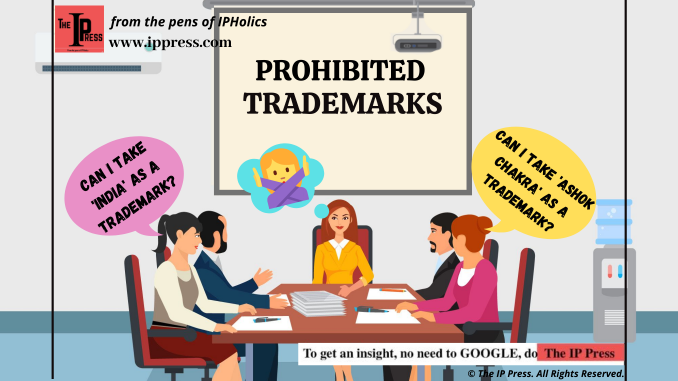
Thinking of a new innovative business model? A new start-up or product name that could set you apart from the crowd of the ever-growing additions to today’s competitive market?
A trademark is not just a word or a logo, it’s a very strong advertising tool and a medium to ensure that your creation is associated to your hard work and no one else can exploit your goodwill and/or deceive the trust a consumer puts while availing your product/service.
While thinking of an innovative and original trademark that sets you apart is a task in itself, it can be made easier by the theory of elimination, by knowing which marks are prohibited or refused protection absolutely.
One such set of marks that would be refused registration are ‘prohibited marks’ that are discussed in this article. Prohibited marks are those terms, symbols or group of words that are barred by law from being registered for protection. Section 9, 13 and 23 of the Trademark Act of 1999 specifically provides prohibition of such marks to be registered as a trademark.
Let us have a look at the provisions.
Section 9 of Trademark Act 1999, lays down the absolute grounds of refusal for trademark registration.
Clause 1.
a). If they are not distinctive: Words so common that they would not be able to attribute any distinctive remembrance in the mind of the consumer. E.g Words like red, or blue or tree, essentially general English word which have not acquired any secondary meaning.
(Windows is a general English terms, but it acquired a secondary meaning after creating a distinct market recognition for itself.)
b). If they are suggestive, or descriptive of the product and its quality, purpose or geographical location in a way that is common to the industry or production of the good/service. , E.g. Best Rice, Tasty Bread, Whole Foods, etc.
c). If they are words referring to common practice, or customary to the trade of such good/services, or generic terms which could cause unfair competition to anyone is similar trade. E.g. ‘Ivory’ for anyone who works with products made of elephant tusk, or ‘Chandan’ for those who work with sandalwood products.
Clause 2.
a). It is causes confusion amongst the consumers or deceives them, through misrepresentation, of the source or the characteristics of the product or aims to defraud. E.g. If another clothing brand uses the name ‘Duma’ with a panther as its logo, it would be closely resembling to ‘Puma’ or like using ‘Bilseri’ instead of ‘Bisleri’ on water bottles.
b). If it contains any terms or makes implications which could hurt the religious sentiments of any citizen of India. It is important to note that using names of God or Goddesses is not considered as offensive but to show any distasteful fashion or make associations which could lead to offensive susceptibilities they would be rejected.
[There are certain pictures and names of God, Goddess and religious heads which are prohibited from getting trademark protection by the notification of the Central Government under section 23(1) of the Trademarks Act, 1999. These are still applicable and refusal under this section would also be valid.]
c). If it uses any term or word that may be deemed obscene, scandalous or offensive on moral grounds or could incite criminal behavior or be discriminatory to any class or citizen is to be refused registration.
d). If the use of any term or symbol or word is prohibited under the Emblems and Names (Prevention of Improper Use) Act, 1950. All such prohibitions are mentioned in the schedule of the Act, and the Central Government as the power to make additions to the same. While Section 3 and 4 of the Act prohibit the names and uses of emblems. The schedule with the list of prohibitions is attached herein. https://indiacode.nic.in/bitstream/123456789/1896/1/A1950-12.pdf
Clause 3
a). The shape of the good is a natural result of the good itself. E.g. you cannot register the shape sphere for ball.
b). The shape is a necessity to achieve the technically optimum result. E.g. If you create a razor with a shape which provides better shaving experience then such shape would not be registered. (Read further: Phillip v Remmington).
c). The shape adds substantive value to the product. Creating a chair for toddlers with attached rattlers, could ass substantial value to the product by the virtue of the shape.
- Section 13 of the Trademark Act prohibits the registration of chemical elements as names along with international non-proprietary names.
Clause a) Prohibits commonly used names of a single elements or accepted single chemical compound in reference to chemical preparation or substances.
Clause b) Prohibits those which are declared by WHO and notified by the registrar as an international non-proprietary name or similar name which could cause deception.
[Even those symbols which universally are accepted associations to medical or healthcare industries like Red Cross, White cross on green background or those mentioned under Geneva Convention Act, 1960]
- Section 23 (1) of Trademark Act prohibits the registration of those trademarks notified by the central government to refused trademark protection.
According to the Manual of Trade Marks, Practice and Procedure by the Central Government[1] there is a list of notified prohibited trademarks which includes:
“1. Words “UNITED NATIONS”, letters “UNO” and the official Seal and Emblem of UNO.
2. The device of an arrow on the ground that is the property of the Government of India.
3. Letters “N.C.L.”.
4. Letters “I.S.I.” if applied by any person or body other than the Indian Standards Institution.
5. Letters “I.C.S.”,
6. Letters “N.P.L.”
7. Words “ASHOK CHAKRA” or DHARMA CHAKRA” or the device of Asoka Chakra or any other colourable limitation thereof.
8. The British Royal Arms, The British Crown or the Union jack or any colourable limitation thereof.
9. Letters “I.S.O.” if applied by any person or body other than the Indian Standards Institution.
10. Words “Lord Buddha” or the device of Lord Buddha or any colourable imitation thereof.
11. Words “Shree Sai Baba” or the device of Shree Sai Baba or any colourable imitation thereof.
12. Words “Sri Ramkrishna, Swami Vivekananda, the Holy Mother alias Sri Sarada Devi or the devices of Sri Ramkrishna, Swami Vivekananda, the Holy Mother alias Sri Sarada Devi and the Emblems of the Ramkrishna Math and Mission or colourable imitation thereof.
13. Words “National”, and “Panchsheel”,
14. Following common names for pesticides:- Aldrin Dinex Allethrin Dinosam Bhc Neod Gamma-Bhc Mazidox Chlordane Mipafox Chlorobenzilate Chlorfenson Pp-Ddt Chlorpropham Ddt Dinoprop Diazinon Dnoc Dieldrin Endrin Dnc Fenson Heptachlor Hhnd Hethoxychlor Lindane Parathion Warfarin Schradan Atraton Toxaphene Azinphos-Ethyl Ferbam Azinphos-Methyl Thiram Dazomet Zineb Dimethoate 2,4,D Fenoprop 2,4,5- T Fenthion Mcpa Mecarbam Propham Mevinphos Antu Morphothion Malathion Paraquat Chlorbenside *[ Coumachlor, dichlone, dimefox , dinoseb, maneb, nabam, parathion-methyl, Proxan-Na or proxan-sodium , Tecnazene, TEPP, ziram , Captan, sulfotep]
15. Letters “IR”
16. Names and pictures of Sikh Gurus, viz. Guru Nanak, guru Angad, Guru Amar das, Guru Ram Das, Guru Arjun dev, Guru Hargobind, guru Har Raj, Guru Har Krishnan, Guru Teg Bahadur and Guru Govind Singh
17. Name and picture of Chhatrapati Shivaji Maharaj
18. Letters “STC”.
19. Name and/or picture of the deity of Lord Venkateswara and/or Balaji
20. Representation of the Election Symbol of any political party in India.”
One such example of a prohibitory mark from the list available on IP India (Trademark office website) is the name “Gandhi”. Upon conducting a public search in the records of the trademark registry, I was amazed to find that the word “Gandhi” (“match with”) has been applied for registration by many applicants in almost all the classes but it has not been outrightly objected by the Trademark office for being a prohibitory mark at all the instances. For Example
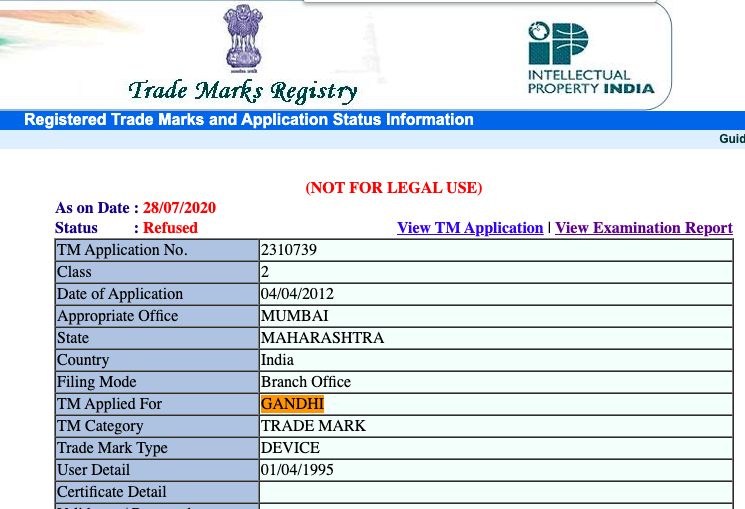
In view of the above instance, it appears that the Indian Trademark Office is not strictly considering the list of prohibitory marks for objecting/rejecting the TM applications at first sight.
Well! Before I would have reached a conclusion criticising the conduct of the Indian trademark office, I just found that the same TM office has also objected the marks – particularly “Gandhi”– for falling under the list of prohibitory marks.
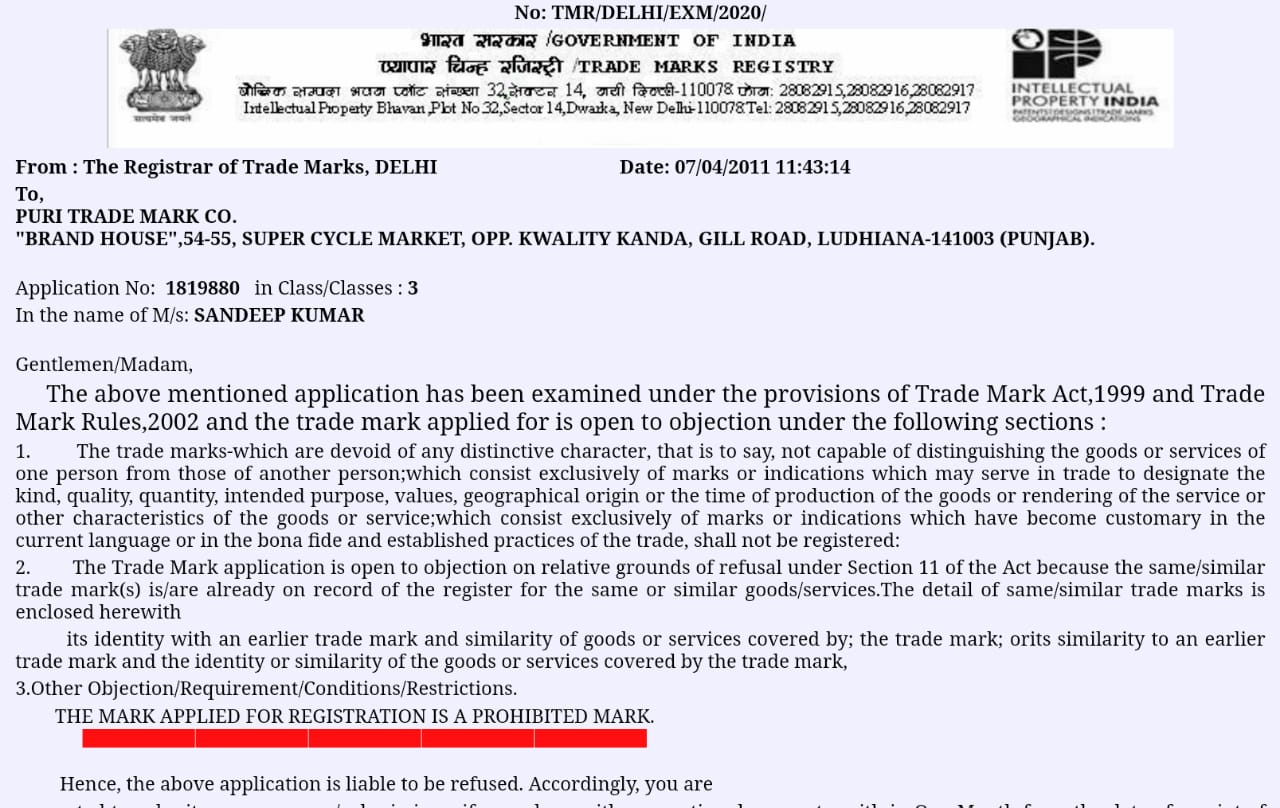
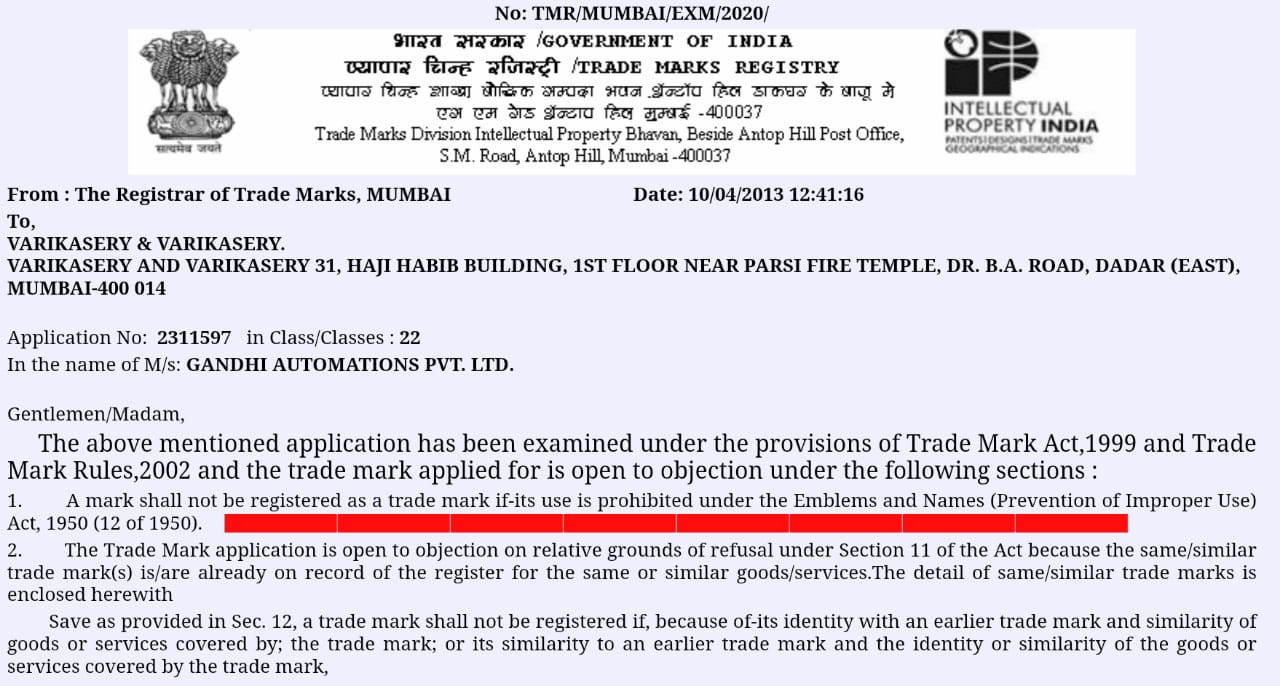
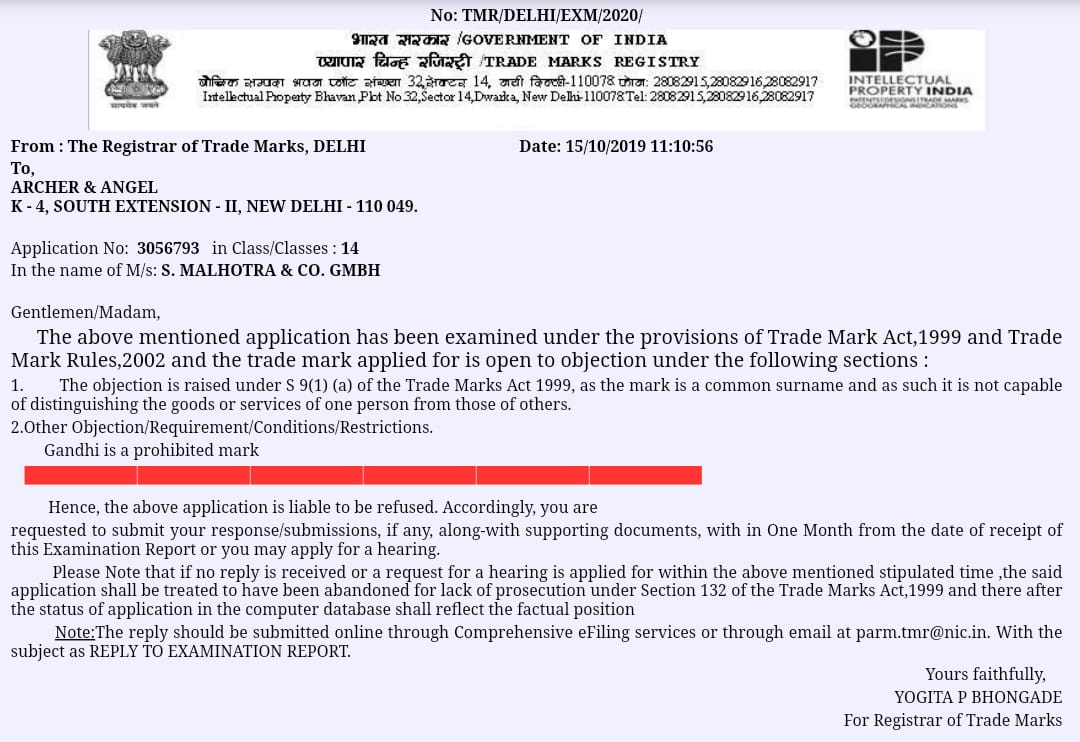
Thus, the TM applicants should be aware of the list of marks that are outrightly prohibited from registration in order to save costs. On the other hand, the TM registry should also diligently refer the list or any such other statutory requirements before issuing an examination report in all the cases and such uncertainty in objections should be reduced. As the non-uniform conduct by trademark office would make the applicants incur more costs at the later stage (For say, hearing stage), which they could have simply avoided if the TM office has earlier objected/rejected the mark under the right provisions.
[1] http://www.ipindia.nic.in/writereaddata/Portal/IPOGuidelinesManuals/1_32_1_tmr-draft-manual.pdf
Interesting observation. I don’t quite understand how non-uniform application of the grounds of objection (or rejection) matter. Under any circumstances, whatever the ground may be, the mark ‘GANDHI’ is disallowed from registration.
Thank you for your comment.
Agreed! Uniformity here is just in reference to the diligence a registry must practise while awarding TM registration 🙂 if they are more proactive into ensuring if a certain term is prohibited or not, it would save time, money and effort for everyone involved.
That’s right. To add a little more, rejecting or objecting a TM application at the first instance for filing a prohibitory mark is an indication of an absolute denial; there is no left or right argument that can be made. However, if the mark is objected alone for lacking distinctiveness or some other objections (and no objection on the prohibitory mark), one can always argue against it. Eventually, say at the hearing stage, the TM office might issue another objection on the same application for claiming a prohibitory mark, but then the applicant would have already incurred costs of the legal representation, used the mark widely, advertisements, etc. Therefore, it is necessary that correct objections should be issued by the TM office in the first instance.
Very informative.